Nice 'old-fashioned' Holland Festival: a special line-up that confronts the audience with the implications of their own position and viewing behaviour. And that's just as well with Fassbinder's 'Die bitteren Tränen der Petra von Kant'. Melodrama was no stranger to the German theatre and film wizard. The bitter tears are of a fashion queen and her entourage, clinical is the setting, wafer-thin the story, and yet unusually exciting how this lady drama develops.
Clean zoals alleen Duitsers het chique vinden, bovendien op te hoge hakken en te strak gekapt – kitsch is het woord voor de toneelsetting, of über-esthetisch. Maar de witte bak met vensterwand rondom, waardoor het publiek niet alleen een blik op de vloer heeft, maar ook bij elke donkerslag uitgebreid zichzelf en elkaar kan bekijken, doet meer. Regisseur Martin Kušej en scenograaf Annette Murschetz lijken een combinatie van “De Anatomische Les” van Rembrandt en Ridley Scott’s “Gladiator” voor ogen gehad te hebben, toen ze deze theater-arena-anatomicum ontwierpen. De acteurs waren er rond als beesten in een ring, maar ook de toeschouwers zitten opgesloten, in hun loges.
Alsof de beslotenheid van de regie-kabine is opengesteld voor het publiek dat een dagje ‘TV achter de schermen’ wil meemaken. Een kijk- en luisterspel is het. De kunstoffen beglazing beweegt vervaarlijk mee wanneer de actrices de alomtegenwoordige vierde wand opzoeken, maar houdt het publiek keurig op afstand. Ook de tekst wordt bemiddeld, versterkt via de installatie en in vertaling via headsets, aan het publiek kenbaar gemaakt. Veilige afstand, aapjes kijken, alles is ‘live’ aan deze gebeurtenis, maar het blijft second-life.
 Tegen dit alles in, spelen de actrices in “Die bitteren Tränen …” alsof hun leven er vanaf hangt. Stevige vrouwen, jong en stralend meestens, vaak hurkend op de met bijna lege Sekt-flessen gevulde vloer. De kracht vanuit de dijen, of het nu om het leven op hoge hakken gaat, over sexuele veroveringen of over hangen in je eigen lijf als harnas, is indrukwekkend. Het hadden wellicht ook vijf mannen kunnen zijn, die dit leed van bezitten en bezeten worden uitspelen, maar dat hurken op hakken zie ik hen toch niet gauw doen.
Tegen dit alles in, spelen de actrices in “Die bitteren Tränen …” alsof hun leven er vanaf hangt. Stevige vrouwen, jong en stralend meestens, vaak hurkend op de met bijna lege Sekt-flessen gevulde vloer. De kracht vanuit de dijen, of het nu om het leven op hoge hakken gaat, over sexuele veroveringen of over hangen in je eigen lijf als harnas, is indrukwekkend. Het hadden wellicht ook vijf mannen kunnen zijn, die dit leed van bezitten en bezeten worden uitspelen, maar dat hurken op hakken zie ik hen toch niet gauw doen.
Iets al te menselijks kleeft het verhaal van blinde liefde en manipulatie aan. Het stuk van Fassbinder, uit 1971 maar nog steeds zeer populair, doet ook niets anders dan de bitterheid tonen. Geen enkele poging wordt er gedaan om het van moeder op dochter overgedragen emotionele misbruik en verraad te verklaren. Iets stoms heeft het daarom, met elkaar opgesloten mensen die elkaar slechts kapot kunnen vechten en dan tussendoor hardgrondig sorry roepen.

Het laboratorium is hun habitat, vertel dat een goed stel acteurs en een regisseur. Zij kunnen de onderbuik ongemeen laten regeren en op geloofwaardige wijze lallende wanhoop, vileine excuses en zwijgende gelatenheid combineren tot dagelijkse kost. Intens en fysiek is het spel, al blijft het haast klein of in ieder geval zeer dicht op de huid van de actrices. Het ego schopt om zich heen, de macht van de verbeelding regeert en Petra von Kant gaat een gewisse ondergang tegemoet. Haar verbeelding regeert en niets of niemand weet daar doorheen te breken. De voorstelling heeft daarom ook iets onwezenlijks: de tekst is uit een tijd waarin yoga en mindfulness nog niet aan hun opmars waren begonnen en zelfmedicatie door drank en drugs nog bon ton was. De schreeuwende eenzaamheid was nog lekker onherroepelijk.
U kunt nog op de wachtlijst. De laatste voorstelling, vanavond te zien in het Muziekgebouw aan het IJ, is uitverkocht.
Anders biedt de website van het Residentztheater misschien uitkomst.
Fassbinder’s Die bitteren Tränen der Petra von Kant
